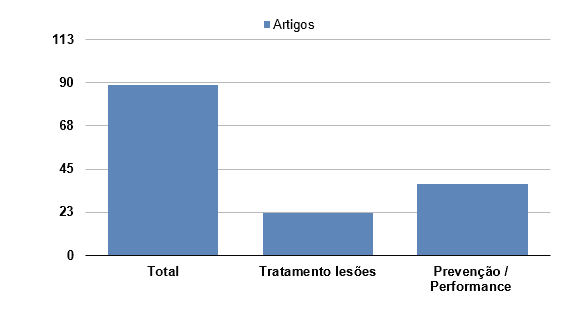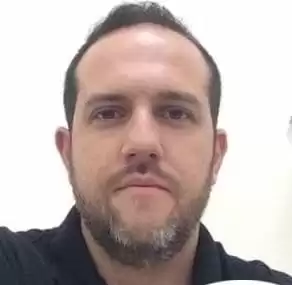REVIEW ARTICLE
JUNIOR, Julio Cesar Dias [1]
Junior, Julio Cesar Dias. Acupuncture in prevention, treatment of injuries and improvement of performance in athletes: Literature review. Revista Científica Multidisciplinar Núcleo do Conhecimento. 04 year, Ed. 10, Vol. 10, pp. 59-98. October 2019. ISSN: 2448-0959, Access link in: https://www.nucleodoconhecimento.com.br/health/acupuncture-in-prevention
SUMMARY
Studies have shown that acupuncture improves physical performance in professional athletes, but the big problem is sports injuries, which can leave them away from activities for long periods. The study conducted a literature review, seeking the efficacy of the technique in the prevention, improvement of performance and in the treatment of lesions. Some authors exemplify and clarify the process of pain neurophysiology and the way in which acupuncture can intervene in this problem, others, develop and apply protocols to achieve an improvement in performance, treatment of diseases and prevention of Injury. Among the results were found eighty-nine articles on the subject, where: twenty two reported the treatment of lesions and thirty-seven the prevention and improvement of athletic performance, directing the application once in the week, of 20 – 30 minutes, presenting satisfactory results for the analyzed data. Based on this literature and evidence-based practice it can be concluded that acupuncture is a great intervention to achieve these goals within the area of sport.
Keywords: Acupuncture, injuries, pain, performance.
INTRODUCTION
For several millennia acupuncture has been used as a form of prevention and treatment of various diseases of the body. This technique of Chinese medicine manipulated needles of stones and fish pimples throughout the stone age (3000 years BC). 1, 2 The Classic Yellow Emperor: Huang Di Nei Jing, constituted one of the oldest records of Traditional Chinese Medicine (MTC), integrating to the present day the philosophical bases, which conceptualizes the balance of the universe and nature, which in its (Chinese) vision, energy is called Chi or Qi. This factor has two antagonistic principles that are completed and tend to be in balance, even though it is under the influence of the universe, called Yin and Yang. 3
Acupuncture is defined as the harmonization of the individual with the environment in which he is, not only, of inserting needles and remedying the problem of the disease, but achieving the ideal of prevention of various pathologies. 4, 5 It is a procedure performed with therapeutic objective, is not toxic, without the use of chemical elements, with minimal side effects, although it is able to release endogenous substances such as neurotransmitters. 4, 6, 7, 8, 9
The intervention is to stimulate the acupoints to achieve the desired therapeutic effect and achieve the homeostasis of the organism. Many studies exemplify the effects of non-opioid neural theory (inhibits nerve impulses acting on the peripheral and central nervous system); humoral theory (stimulates release of endogenous opioids, other hormones and neurotransmitters).10, 11 Purpose in pain control, the association of needles with electrical current, called electroacupuncture, potentiates and presents benefits in the clinical practice, in addition to being used also as: auricular acupuncture; skullpuncture; moxabustão; suction cups; laser acupuncture. 3, 10
In sports, the use of technology in search of better results continues to grow, exceeding the limits of the human body. Several natural or integrative therapies are studied as a source of complementary therapy to improve athletic conditions. Although the number of studies is scarce, the acceptance of acupuncture is still very curious, since many individuals still doubt the scientific evidence. 9 However, its use in the sports environment has been increasing, acting in the treatment of pain and athletic injuries, accelerating the process of recovery of the individual. Another issue presented is the effective intervention in improving physical performance and preventing injury from amateur and professional athletes. 12, 13, 14
GOAL
The objective of this work was to conduct a bibliographic survey of the use of acupuncture in prevention, improvement of athletic performance and in the treatment of injuries in various sports modalities.
METHODOLOGY
A bibliographic survey was conducted in the Databases Scielo, Google Acadêmico, and Scoopus, to obtain information about: acupuncture in the prevention, improvement of performance and in the treatment of sports injuries. The following keywords were used: acupuncture; acupuncture and pain; acupuncture in prevention; sports injury and acupuncture; acupuncture and improvement of athletic performance; treatment of injuries and acupuncture.
To delimit the cutout of this study, an initial screening was performed among the numerous articles found, totaling 89 manuscripts, selecting 22 that addressed the acupuncture subject in the treatment of injuries and 37 addressing the prevention of sports injuries and improving athletic performance. Based on this analysis, it is worth mentioning that of all studies found primarily, the universe of research comprised 59 articles published in scientific journals, congress estates, books, websites, which in the title, abstract or keywords terminologies used during the research.
RESULTS AND DISCUSSION
In this search resulted in several articles (Graph 1; Table 1), having been performed in isolation through the key words.
Graph 1: Total number of articles found and used in the search.
Table 1: Articles related to prevention, improvement of athletic performance and treatment of sports injuries.
| Authors | Article Title | Journals/Anais/Congresses/Sites |
| Ehrlich D, Haber P, 1992 | Influence of acupuncture on pysical performance capacity and Haemodynamic Parameters | J. Sports Med |
| Santos VC, Kawano MM, Banja RA, 2008 | Acupuntura na melhora da performance em atletas juvenis de handebol | Rev Saúde e Pesq |
| Rubio K, Godoy Moreira F, 2008 | A dor em corredores com fascite plantar: o uso da acupuntura | Rev Dor |
| Pires TF, Pellegrinotti IL, 2010 | Acupuntura na Performance Atlética: Estudo Exploratório | 8ª Mostra Acadêmica da UNIMEP |
| Yang HY, Liu TY, Gao M, 2006 | Electrical acupoint stimulation increases athletes rapid strength | Zhongguo Zhen Jiu |
| Luna MP, Fernandes Filho J, 2005 | Efeitos da Acupuntura na performance de Atletas velocista de alto rendimento do Rio de Janeiro | Fit e Perform J |
| Dias Junior JC, Marino DM, 2019 | Acupuntura na prevenção de lesões musculares em atletas de futebol profissional | Rev Fisiot S Fun |
| Maciocia G, 2007 | Os fundamentos da medicina chinesa: um texto abrangente para acupunturistas e fitoterapeutas | Book |
| Akimoto T, Nakahori C, Aizawa K, Kimura F, Fukubayashi T, Kono I, 2003 | Acupuncture and responses of imunoligic and endocrine markers during competition | Med Sci in Sports Exerc |
| Karvelas BR, Hoffman MD, Zeni AI, 1996 | Acute Effects of Acupuncture on Physiological and Psychological Responses to Cycle Ergometry | Arch Phys Med Rehabil |
| Fry AC, Kraemer KJ, 1997 | Resistance exercise overtraing and overreaching: neuroendocrine responses | Sports Med |
| Knardahl S, 1998 | Sympathetic nerve activity after acupuncture in humans | Department of Clinical Neurophysiology |
| Barlas PJ, Robinson JA, Baxter GD, 2000 | Lack ofeffect of acupuncture upon signs and symptoms of delayed onset muscle soreness | Clinical Physio |
| Rossetto SC, 2009 | Acupuntura nos Esportes | Book |
| França D, Fernandes-Senna V, Cortez CM, 2004 | Acupuntura cinética como efeito potencializador dos elementos moduladores do movimento no tratamento de lesões desportivas | Fisioter Bras |
| Wadsworth L T, 2006 | Acupuncture in sports medicine | Curr Sports Med Rep |
| Barela J A, 2000 | Estratégias de Controle em Movimentos Complexos: Ciclo Percepção – Ação no Controle Postural | Rev Paul de Educ Fís |
| Papler PG et al., 1999 | Reabilitação do joelho. In: Greve J.M. A. e Amattuzzi, M.M. Medicina de reabilitação aplicada à ortopedia e traumatologia | Book |
| Gemeo LH. Ignatti C, 2004 | Acupuntura como Ferramenta Auxiliar do Aumento da Performance Desportiva. In: Anais do Simpósio Internacional de Ciências Integradas da UNAERP | Anais Simpósio |
| Frasca L, 2011 | Desempenho na Ponta da Agulha | Rev Farmac |
| Costa V, 2013 | Acupuntura Previne Lesões e ajuda a melhorar o Desempenho nas Pistas [periódico na internet] | http://blogs.oglobo.globo.com/pulso/post/acupuntura-previne-lesoes-ajuda-melhorar-desempenho-nas-pistas-500798.html. |
| Luna M, 2016 | Os Benefícios da Acupuntura no Esporte | http://www.ibramrp.com.br/noticia/49/os-beneficios-da-acupuntura-no-esporte |
| Bopp-Limoge C, 1998 | L`acupuncture Permet-elle D`ameliorer les Performances Sportives Stude Personnelle a Propos de 35 Sportifs de haut niveau. | These Medicine |
| Lin ZP et al., 2009 | Effects of acupuncture stimulation on recovery ability for male elite basketball athletes | Amer Jour of Chin Med |
| Lin, ZP et al., 2009 | Effect of auricular acupuncture on oxygen consumption of boxing athletes | Chin Med Jour |
| Dhillon S et al., 2008 | The acute effect of acupuncture on 20-km cycling performance. | Clin Jour of Spo Med |
| Hubscher M et al., 2010 | Immediate effects of acupuncture on strength performance: a ramdomized, controlled crossover trial | Euro Jour of Appli Physi |
| Geng L J et al., 1995 | Investigation on the effects of ear acupressure on exercise-induced lactic acid levels and the implications for athletic training | Amer Jour of Acupu |
| Franco RS, 2012 | Avaliação do Efeito da Acupuntura sobre o Desempenho Físico pelo Teste do Banco de Harvard | Dissertação |
| Fonseca LP, Lessa JFM, 2011 | Efeito da Aplicação da Acupuntura na Resistência Muscular Localizada de Membros Superiores em Praticantes de Exercício Resistido. | Monography |
| Belmiro H, Vicentini D, Camilotti CM, 2013 | Efeitos da Acupuntura no Desempenho Motor de Atletas. | Rev Fac Educ Fis |
| Rubio K; Godoy Moreira F, 2007 | A representação da dor em atletas olímpicos brasileiros | Rev Dor |
| Parisotto D, 2014 | Efeito Imediato da Aplicação da Acupuntura na Dor Muscular Tardia e na Capacidade de Contração Muscular | Dissertation |
| Staud R, 2007 | Mechanisms of acupunture analgesia: effective therapy for musculoskeletal pain? | Curr rheumatol Rep |
| Bucinskaite V, Lundeberg T, Stenfors C, Ekblom A, Dahlin L, Theodorsson E, 1994 | Effects of electro-acupuncture and pysical exercice on regional concentrations of neuropeptides in rat brain | Brain research |
| Shang C, 2009 | Prospective tests on biological models of acupuncture | Evid Based Complement Alternat Med. |
| Bowsher D,1988 | Mechanisms of acupuncture. In: Filshie J, White A. editors. Medial Acupuncture: a western scientific approach. | Book |
| Ma SX, 2004 | Neurobiology of acupuncture: Toward CAM | Evid Based Complement Alternat Med |
| Li J, Wang Q, Liang H, Dong H, Li Y, Ng EH, et al., 2012 | Biophysical characteristics of meridians and acupoints: a systematic review. | Evid Based Complement Alternat Med. |
| Lee, SH, Chung, SH, Lee, JS, Kim, SS, Shin, HD, Lim, BV, et al., 2002 | Effects Acupunturaq on the 5-hydroxytryptamine synthesis and tryptophan hydroxylase expression in dorsal in the dorsal raphe of exercice rats. | Neurocienses Letters |
| Zyloney CE, Jensen K, Polich G, Loiotile RE, Cheetham A, LaViolette PS, et al., 2010 | Imaging the functional connectivity of the Periaqueductal Gray during genuine and sham electroacupuncture treatment. | Mol pain |
| Minori AET, Mejia DPM, 2007 | Atuação da Acupuntura para o Tratamento de LER/DORT no Ombro. | Monography |
| Brum KN, Alonso, AC, Brech GC, 2009 | Tratamento de massagem e acupuntura em corredoresrecreacionais com síndrome do piriforme | Arq Cienc Sau |
| Hongwen S, 2003 | Clinical Observation on Acupuncture Treatment of Piriformis Syndrome. | J Tradit Chin Med. |
| Rocha TBX, Vilela Junior GB, Martins GC, Manzatto L, Grande AJ, 2012 | Análise Comparativa Eletromiográfica do Reto Femoral em Isometria na Posição Inferior do Agachamento Wall Slide, antes e após a Aplicação da Acupuntura no Ponto ST45 | Rev Bras Cien e Mov |
| Pinheiro RG, Mejia DPM, 2012 | Efeito da Acupuntura na Melhora do Paciente com Quadro Álgico de Lesão de Menisco Medial. | Monography |
| Nunes EA, Mejia DPM, 2012 | Tratamento de Acupuntura para Combater Dores nos Ombros. | Monography |
| Tolentino F, 2016 | Efeito de um Tratamento com Auriculoterapia na Dor, Funcionalidade e Mobilidade de Adultos com Dor Lombar Crônica. | Dissertation |
ACUPUNCTURE IN THE PREVENTION OF INJURIES
The prevention of injuries in sport is a great battle to be won by professionals who work with athletes. In football, muscle injury corresponds to 20-40% of all sports injuries, predominantly 80-90% in the lower limbs. 15
Muscle injury is the great villain of all athletes, from various sports, and can leave them away from their activities for a long period. Thus, it is interesting to present a proposal for prophylactic intervention, bringing the idea of a technique to prevent or reduce the risks of this type of injury in athletes. In this case acupuncture proves to be a beneficial technique.
In his study, Dias Junior 16, was attended by 54 male athletes, belonging to a professional football team. They were distributed into 6 groups: group 1 – acupuncture to rebalance the system, found through evaluation; group 2 – which received protocol with specific points: spleen pancreas 3, spleen pancreas 6 (Figure 1A) and stomach 36 (Figure 1B); group 3 – stomach 36 (Figure 1B); group 4 – spleen pancreas 6 (Figure 1A); group 5 – ear acupuncture; control group – received no intervention. After eight sessions, one per week, the results showed: groups 1 and 2 did not present any type of injury; group 4: two lesions; groups 3 and 5: presented 1 lesion; control: presented 6 cases of muscle problems.
Figure 1 A: spleen pancreas 3 – on the medial side of the foot, posttero-inferior of the metatarsal-phaline joint, in the line of the junction of dark and light skin; pancreas spleen 6: 3 tsun above the medial maleolus, on the posteromedial edge of the tibia; B: stomach 36 – 3 tsun below the patella between the anterior tibia muscle and the long extensor muscle of the fingers; stomach 37 – 3 tsun below Zusanli (E36), on the lateral anterior side of the tibia muscle; stomach 38 – 8 tsun below the knee, 2 tsun below the Point Shangjuxu (E37), on the side of the anterior tibia muscle; stomach 41 – at the dorsal midpoint of the ankle above the cruciate ligament, between the tendons of the long hallux extensor muscle and the long extensor of the fingers.
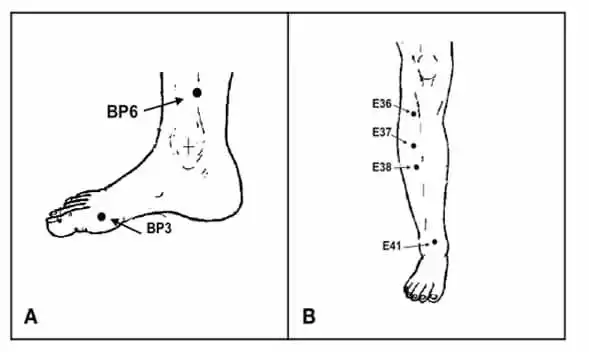
The pancreas spleen has the function of extracting energy from food, distributing to the body and controlling blood within blood vessels. The strong presenting Qi will be transported to all muscles in the body, specifically to the limbs, but if the Qi is in deficiency, the energy will not be transmitted to muscle tissue and the athlete will present fatigue and weakened muscles.18
According to Ross 19, the spleen points pancreas 3 and 6 are associated with stomach 36 by tonining blood Qi. The earth element is responsible for energy balance and the availability of Qi and blood as energy sources for mental, emotional and physical activity. THE MTC, reports that by toning this element, it maintains the muscles nourished by Qi and Xue (blood in THE MTC), aiming at improving athletic performance. This maintains the obligation to tone the organ that produces Xue (Liver) and maintains the energetic fluid (Spleen Pancreas and Kidney), since the functionality of the blood is to nourish the body, in addition to completing the nutrient action of Qi.
Muscle training, relaxation and contractile strength is related to liver xue nutrition. If nutrition is deficient, cramps and paresthesia of the limbs will cause injury. On the other hand spleen monitors the xue inside the vessels and removes qi from transmitting foods to the body: Strong Qi, will transmit good energy to the muscles; a weakened Qi will result in a tired and weak muscle. 19, 20
Based on this evidence this technique is practiced in sports presenting rapid results, improving the quality of muscle strength, cardiorespiratory conditions, flexibility and mental and physical well-being of sportsmen. 20, 21, 22 Yang and employees 22, achieved a significant increase in muscle strength, providing improvement in the speed of athletes. In turn, Luna and collaborators 24, stated that stimulation of acupuncture points improves sports performance, muscle plasticity preventing injuries.
A study conducted in Japan highlights the effect of acupuncture on the physical well-being of female soccer players during the competition. They were divided into two groups, where one was submitted to treatment and the other control. Cortisol levels (endocrine system assesses) and physical well-being assessment were evaluated using the POMS questionnaire (assesses physical and mental status): an improvement in the immune system was observed ( decreased SIgA secretion), improved mental stress (decreased cortisol) and improves physical well-being, flexibility and muscle tension. 25
However Ehrlich and employees 25, achieved an improvement in athletic performance, increasing the level of physical well-being, improving competitive response, during training and games, assisting in the recovery of muscle capacity.
Other lesions that can be prevented with acupuncture are ankle sprains, which affect the ligaments, triggering many pains and limitation of joint function. France 26, used the ashi points (painful points to palpation), associated with bladder 60 (Figure 2A) to eliminate pain; the gallbladder 39 that reinforces the bones, tendons and fights the algia in the extremities; and gallbladder 40 stimulates Qi and xue; stomach 41 (Figure 2B) that treats lateral changes of the ankle and stomach 36 (Figure 1B) eliminating obstruction and stimulating the circulation of Qi and local xue.
Figure 2 A: bladder 60 – between the Achilles tendon and the edge of the lateral soleolus of the ankle, at the level of the highest point of the maleolus; B: gallbladder 39 – 3 tsun above the highest point of the external maleolus, in depression between fibula and long and short fibular tendons and gallbladder 40 – on the antero-inferior side of the outer maleolus, in lateral depression of the tendon of the long digital extensor muscle ; stomach 41 – at the dorsal midpoint of the ankle above the cruciate ligament, between the tendons of the long halux extensor muscle and the long extensor of the fingers.
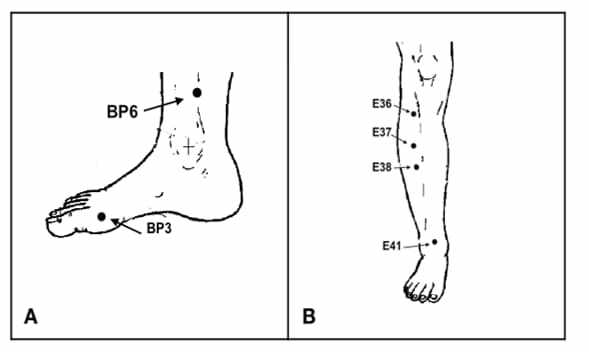
Some athletes may be surprised with spraincolor, which is defined as a cervical tendon injury that causes muscle pain and stiffness. There is a protocol to remedy this problem and return the athlete to his duties. Wadsworth 27, used in addition to the ashi points that stimulate the circulation of Qi and xue, the gallbladder 39 (Figure 2B), gallbladder 20 acts in the circulation of Qi and xue, relaxing tendons and soften pain; governor ousse 14 expelling the pathogenic factor and regulating meridian Qi; bladder 10; small intestine 14; gallbladder 21 (Figure 3A) stimulate the circulation of Qi and xue. If joint block limits flexion and extension, use bladder point 60 (Figure 2A). Small intestine points 3, lung 7 promote the circulation of Qi and xue of the neck, if it has rotation limitation, use the small intestine point 7 that drains the Taiyang meridian of the hand (Figure 3B).
Figure 3 A: gallbladder 20 – below the occipital edge in depression between trapezoid and sternum-clidomastoid muscles, on the margin of hair and gallbladder 21 – at the equidistant point between the Dazhui (VC14) and the shoulder acromion, 1 tsun above the Tianilian point; governor’s vase 14 – at the midpoint between the thorny processes; seventh cervical vertebra and first dorsal vertebra; bladder 10 – at the level between the spines of the second and third vertebrae, 1.3 lateral tsun of the dorsal midline, on the edge side of the trapezoid muscle and small intestine 14 – 3 lateral tsun of the axis of the vertebra; at the horizontal level of the lower edge of the thorny process of the first dorsal vertebra; B: lung 7 – on the medial side of the forearm, 1.5 tsun above the wrist line between tendons of the long thumb adductor muscle and the long extensor muscle carporadial; small intestine 3 – ulnar side of the hand, behind the metacarpal-phalangian joint of the fifth finger, between the light and dark skins; Small intestine 7 – 5 tsun above the wrist, on the ulnar side of the carpal-ulnar extensor muscle.
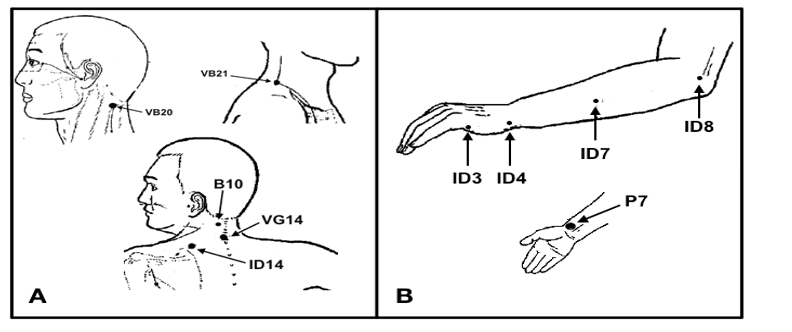
Overloading the elbow joint, affects, especially tennis players, and can lead to a blockade of Qi and xue, triggering a chronic inflammation called epicondilite. Ashi points are used in the region promoting Qi stimulation. 28
For treatment of wrist lesions, such as: tendinitis or tenosynovitis of the thumb, extensors and flexors of the fingers, France 26, used the ashi point associated with the large intestine 5 to disperse the heat of the meridian; small intestine 5 eliminating heat and unlocking the wrist (Figure 4A); Triple heater 4 that in addition to eliminating heat ceases inflammation and the large intestine 11 (Figure 4B) unlocking qi and xue calming the pain.
Figure 4 A: small intestine 5 – on the ulnar side of the wrist, in the depression between the pisiform and the ulnar styloid process; Large intestine 5 – on the back-radial side of the wrist, a little distal of the radio bone, where there is depression between the tendons of the extensor muscle short and long of the thumb, when stretching and opening the thumb. B: triple heater 4 – on the dorsal side of the wrist, in the depression in the middle of the dorsal fold of the wrist, between the tendons of the common digital extensor muscles and digital extensor of the fifth finger;large intestine 11 – on the radial side of the elbow, in the brachioradial muscle; when bending the elbow, in radial depression at the end of the cubital line.
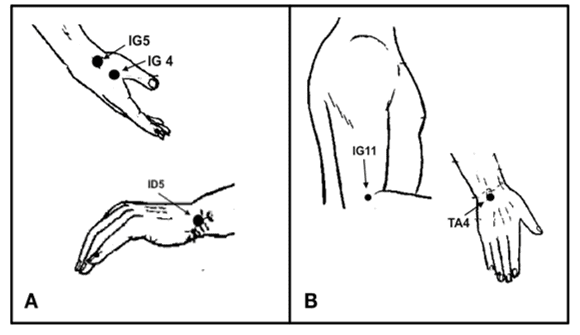
For low back pain, Barela 17, associated ashi points with bladder 23 and bladder 25 to stimulate local Qi and Xue, bladder 40 (Figure 5) that eliminates pain and heat.
Figure 5: bladder 23 – 1.5 tsun, lateral of the lower edge of the spinal process of the vertebra (L2); bladder 25 – 1.5 tsun, lateral of the lower edge of the spinal process of the vertebra (L4); bladder 40 – 3 tsun, lateral of the axis (Du-Mai), at the lower edge level in the second spine of the vertebra (T2).
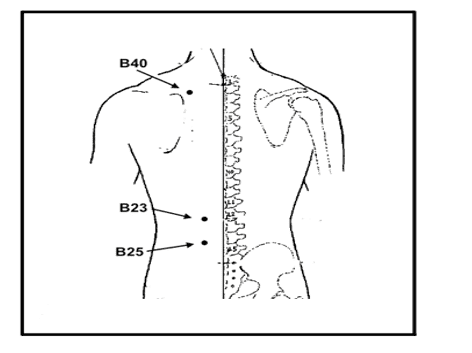
Now another injury that worries football athletes, are ligaments, meniscals and tendons of the knee. This are treated with ashi points, associated with gallbladder 33 (Figure 6) that relaxes tendons and treats pain; bladder 40 (Figure 5) eliminates joint pain, edema and heat, stimulating Qi and xue; stomach 36 (Figure 1B) regulating the flow of Qi and xue of the meridian eliminating obstruction. 29
Figure 6: gallbladder 33 – at the lateral edge of the knee, 3 tsun above the yanglingquan point (VB34), in the upper depression of the lateral epithenodilof of the femur.
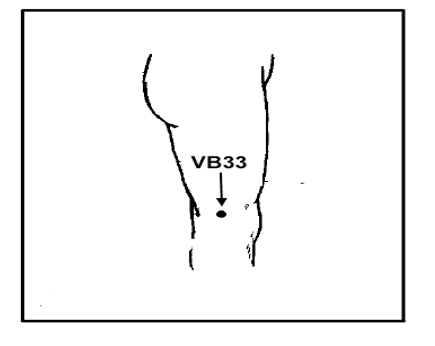
Gemeo 30, stated that acupuncture can promote an improvement in the physical capacity of athletes, prevent and treat injuries that may occur before, during or after sports competitions, in addition to assisting and influencing emotional factors such as anxiety, irritability, insomnia and depression, which can directly hinder the athletic capacity of these individuals. He developed a specific protocol using master acupuncture points, selecting according to the modality (Chart 1):
Table 2: Gemeo 30
| Master of moral energy | governor vase 19 (Figure 7) |
| Master of general energy | influences general energy, acting on ancestral and postnatal energy – governor’s vase 4, 6, 10, 13 (Figure 7) |
| Masters of the upper limbs | acts on forearm movements, wrists, hands and shoulders: triple heater 15 (Figure 7) |
| Master of lungs | interferes in the anterior thorax: lung 1 (Figure 7) |
| Back master | diaphragm, breathing and nn. phrenic: bladder17 (Figure 7) |
| Belly master | influence on abdominal waist: stomach 27 (Figure 7) |
| Master of the kidneys | lumbar waist acts: bladder 47 and bladder 52 (Figure 8) |
| Hip master | acts the mm. glutes and coxofemoral joint (Figure 8) |
| Thigh master | acts in the musculature of the thighs: gallbladder 30 (Figure 8) |
| Lower limb master | influences the action of feet and muscles in general: bladder 58 (Figure 8) and stomach 36 (Figure 1B) |
| Points for improving balance and reflection | vaso conception 4, vaso conception 6 (Figure 9), large intestine 11 (Figure 4B), bladder 46 (Figure 8), governor vessel 4 (Figure 7). |
Figure 7: governor’s vase 4 – in the center line of spine of the spine; in the space between the spines of the second and third lumbar vertebrae; governor vase 6 – in the center line of the column; between the eleventh and twelfth thorny process of the dorsal vertebrae; governor vase 10 – in the center line of the column; between the sixth and seventh thorny process of the dorsal vertebrae; governor’s vase 13 – in the center line of the column; between the first and second thorny process of the dorsal vertebrae; governor’s vase 19 – 1.5 tsun behind Baihui (VG 20); stomach 27 – 2 tsun below the navel and 2 tsun next to the medial line on the lateral edge of the rectus-abdominal muscle; bladder 17 – 1.5 tsun of the axis, at the lower edge level of the spinal process of the vertebra (T7); lung 1 – on the anterolateral side of the chest, below the Yunmen point (P2) (pit between the clavicle and shoulder), in the space between the first and second rib, 6 tsun on the middle line side of the body; triple heater 15 – in the suprascapular pit, between Quyuan (ID13) and Jianjing (VB21).
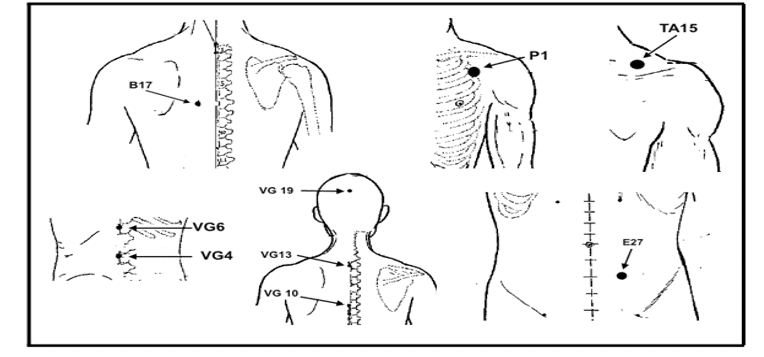
Figure 8: bladder 46 – 3 tsun, lateral of the axis, at the lower edge level of the vertebra spine (T9); bladder 47 – 3 tsun, lateral of the axis, at the lower edge level of the vertebra spine (T10); bladder 52 – 3 tsun, lateral of the axis, at the level of the second spine of the sacrum, at the lateral edge of the iliossacral joint; bladder 58 – l tsun below the side side of chengshan point (B57); 7 tsun above the heel, on the lateral side of the gastrocnemius muscle tendon; gallbladder 30 – in the buttock, in the line between the sacred hiatus and the prominent of the larger trochanter; one third of the lateral distance at the lower edge of the piriform muscle; extra hip point – in the middle of the line ranging from the upper end of the intergluteal groove to the part of the outer crest of the ischio.
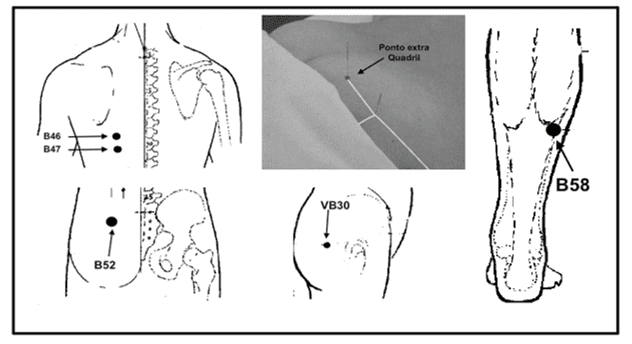
Figure 9: vase conception 4 – 3 tsun below the navel, in the central line of the abdomen; vase conception 6 – 1.5 tsun below the navel, in the center line of the abdomen.
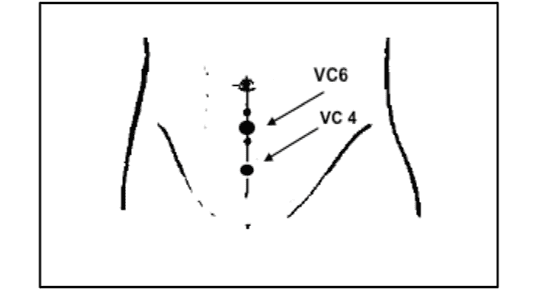
ACUPUNCTURE IN THE IMPROVEMENT OF ATHLETIC PERFORMANCE
When dealing with acupuncture in the prevention of injuries in athletes, we must not forget that achieving this preventive objective, consequently we improve quality and physical integrity and can intervene in improving performance.
In Asian countries the use of acupuncture develops a physical well-being for athletes, regulated by nervous, endocrine, immune systems and as a result, an improvement in physical condition in several modalities. 32, 31, 34 In addition there are points applied before, during and after training and games, which assist in the maintenance of muscles, such as in reducing lactic acid, reducing pain, fatigue, accelerating recovery and improving performance. 35
Acupuncture stimulates the release of biochemical substances that relieves muscle fatigue from intense exercises, besides promoting increased antioxidant activity, decreasing oxidative stress rates. During a study, the athletes received treatment with electroacupuncture for 30 minutes, over a period of 30 days and the result was the significant increase of superoxide dismutase (SOD) and decreased blood malondial (MDA). Superoxide dismutase is an enzyme with antioxidant effects that protects cells against toxic substances by exerting potent anti-inflammatory response in the body. The MDA is related to inflammatory and degenerative diseases, allowing researchers to conclude that electroacupuncture decreases MDA rates and increases SOD, contributing to fatigue relief and improving physical performance. 36
Although it is a millenary technique, its use improves the physical and mental performance of the athlete is recent. Luna, published a research demonstrating that acupuncture statistically improved the maximum strength and potency of sprinter athletes (100, 200 and 400 meters shallow without barriers) and since then the research in this regard has been deepened. 37
In a research, Santos 20 used male Handbol athletes between 15 and 17 years old, where he performed two 100-meter shots in each athlete (pre acupuncture). After 45 minutes of application of the protocol chosen for treatment, he reevaluated in the same way. The points chosen were: bladder 58 (Figure 8) master of the legs and foot; stomach 36 (Figure 1B) tones the striated musculature and is used to potentiate treatment; extra master point of the hips (Figure 8) tones the glutes and increases the flexibility of the coxofemoral joint; gallbladder 30 (Figure 8) master of the thighs and promotes flexibility for the movement of the lower limbs; lung 1 (Figure 7) master of the lungs promotes efficient respiratory work; bladder 17 (Figure 7) master of the back, dorsal diaphragm shu and Xue’s point of influence that regulates respiratory rhythm; triple warmer 15 (Figure 7) master of arms that commands the joint muscle group of shoulders, nape, cervical spine, first six thoracic vertebrae, arms, forearms, wrists and hand.
The results identified a significant improvement, with a decrease in the time in the second battery of the 100-meter tests. The average improvement in the times was 5.72% and the athlete with the best performance achieved reached reached a percentage of 10.84%.
This average of 5.72% achieved in the improvement of performance seems small, but if compared with results of important competitions, we can see the validity of the practice: at the Pan American Games in Rio de Janeiro 2007, in the final of the 100 meters shallow male to difference between 1st place and 8th was 0.23 seconds, representing a time of 2.26% higher, that is, if this athlete achieved an improvement of 5.72% in his performance, he would probably get other results.
There is little scientific attention, when we treat, of acupuncture effects on improvements in the physiological response induced by exercise and few directed to high performance athletes. 24, 38 But Rossetto 31 presents a protocol for improving athletic performance in football and rugby using the following points: bladder 52 and bladder 58 (Figure 8); bladder 17 and lung 1 (figure 7).
The bladder point 58, tones the striated musculature of the entire body, joint of the knees, ankles and feet. It is an important point to avoid fatigue, especially if used with stomach 36. Bladder 17 tones the dorsal muscles, joint ligaments and even increases the flexibility of the vertebral joints themselves, promoting regulatory action on the diaphragm, respiratory rhythm and phrenic nerves. Bladder 52 tones the entire region of the lumbar muscles and promotes willpower. Lung 1 is used to make respiratory work efficient and is related to supraclavicular and intercostal nerves (with deeper insertion) assisting in the brachial plexus. Using with bladder point 17 regularizes respiratory rhythm.
Like Bopp Limoge 39, applied a three-point fixed protocol: liver 5 (Figure 10), triple heater 15 (Figure 7) and bladder 58 (Figure 8), added to two other random points, placebo, in 35 athletes, achieving significant improvement in athletic performance of the individuals tested.
Figure 10: liver 5 – 5 tsun above medial maleolus; at the posteromedial edge of the tibia.
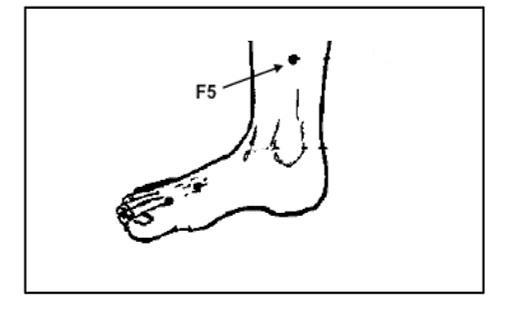
The study by Akimoto 38 corroborates the results of several studies related to the improvement of physical and mental capacity, where he tested twenty-one soccer athletes during the competition phase, biochemically evaluating salivary IgA and cortisol, by rate muscle tension and fatigue, resulting in increased cortisol and lower salivary IgA, confirming the effective improvement in athletic and mental performance.
In another research conducted in the treatment of sports injuries with kinetic acupuncture (association of acupuncture with kinesiotherapy), in athletes of tennis, soccer, volleyball, Olympic gymnastics, capoeira, bale and jiu-jitsu; patients with locomotor disorders such as: Achilles tendonitis, low back pain, back pain, prarcicolo, tenosynovitis, carpal tunnel syndrome, pronador syndrome, muscle contusion, tennis elbow and gonalgia due to meniscus injury. All 31 athletes tested returned to training, at most, until the third session: 53% returned after the first session; 37% after the second; 11% after the third, concluding that this technique acted efficiently accelerating the recovery time of athletes. The explanation for this is that acupuncture acts in the inhibition of the spasm cycle – pain, leading to a segmental afferent block, supraspinal descending block, through pyramidal pathways and activation of the process endogenous analgesics. 26
In another study, the variables of maximum strength, explosive strength, anaerobic resistance and speed in high-yield sprinter corridors were evaluated during a transition period. The liver meridian was focused: liver 1; liver 3; liver 8 (Figure 11A), because the energy functions of this organ are to store blood, control dispersion, drainage and determine tendon and ligament conditions, in addition to controlling the emotional part, because an energy deficit can trigger: depression; irritability; insomnia; disturbing dreams. The first punctured acupoint was bladder 62, gallbladder 34, kidney 3 (Figure 11B), followed by the pancreas spleen 3 (Figure 1A), liver 1, liver 3, liver 8 (Figure 11A), stomach 36 (Figure 1B) and closing with the small intestine 3 (Figure 3B). Liver stitches were introduced in the eighth session. The results were positively impactful, developing an improvement in the functions studied. 24
Figure 11 A: liver 1 – 0.1 tsun above the lateral angle of the nail bed of the toe and liver 3 – between the first and second metatarsals, behind the metatarsal-phalangeal joints; liver 8 – at the end of the medial side of popliteal fold, on the antero-medial edge of the semimembraous and semitendinous muscles. B: kidney 3 – between the posterior edge of the medial maléolus and the Achilles tendon; gallbladder 34 – l tsun below the knee, in anterior and lower depression of the head of the fibula, in the fascia of the long perorean muscle; bexia 62 – 0.5 tsun below the external maleolus, in the lower depression of the maleolus.
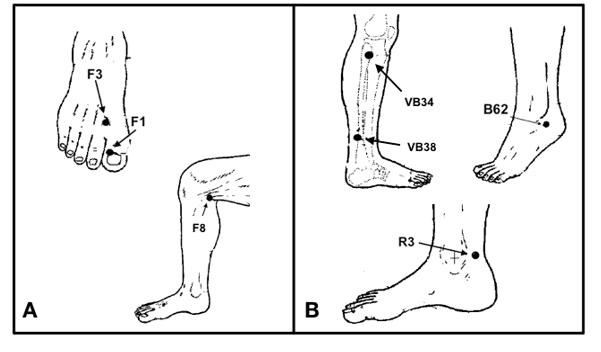
Ehrlich 25, on the other hand, divided 36 male individuals into three groups: one treated with systemic acupuncture; another control group; another with placebo acupuncture. A significant improvement in physical performance and hemodynamic parameters was obtained. One session was held per week at the gubernatorial vaso 20, vaso conception 15 and liver 13, bladder 43 (Figure 12), stomach 36 (Figure 1B) and spleen pancreas 6 (Figure 1A) for 5 weeks. They analyzed that the anaerobic threshold improved by 6.62% and the maximum performance in 7.15% in the group that received systemic acupuncture, already in the control group and placebo, there were no alterations.
Figure 12: governor vase 20 – on the center-vertical head line; 7 tsun above the posterior edge of the hair; 5 tsun behind the anterior margin of hair; vaso conception 15 – 3 tsun above Zhongwan (RM12), in the central line of the abdomen and liver 13 – at the lower edge of the end point of the eleventh rib, on the side of the abdomen; bladder 43 – 3 tsun, lateral of the axis (Du-Mai), at the lower edge level of the vertebra spine (T5).
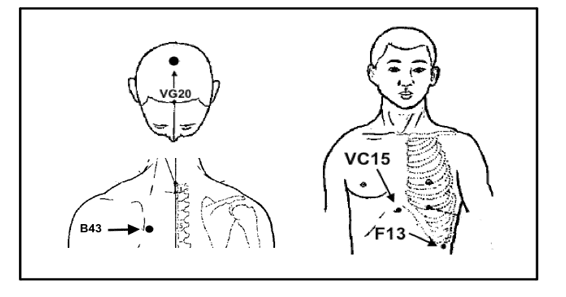
Lin 40, evaluated the effects of ear acupuncture on heart rate (Cmf), oxygen consumption (VO²max) and blood lactic acid in elite basketball athletes. They were divided into 2 groups of 12 athletes each, where: Group 1 – auricular acupuncture; Group 2 – control. Each of the athletes cycled on an exercise bike until exhaustion, and the Cmax, VO2max and blood lactic acid were measured during the rest period, after heating and during exercise: after 5, 30 and 60 minutes. The results showed that HR and blood lactic acid were significantly lower than in the control group, after 30 and 60 minutes of activity.
The same author, Lin 41, in a new research, evaluated the same variables as FCmáx, VO²max and blood lactic acid in 30 basketball athletes, divided into 3 groups: 1- systemic acupuncture; 2- sham group; 3-control. In group 1, the circulation and sexuality point 6 (Figure 13), stomach 36 (Figure 1B) were used and during the study each athlete performed the tests on an exercise treadmill for 15 minutes. The variables were measured in rest and in 5, 30 and 60 minutes after exercise, obtaining a significant reduction of the three variables after 30 and 60 minutes.
Figure 13: circulation and sexuality 6 – 1 tsun below jianshi point (PC5); 2 tsun above the wrist, between tendons of long palmar muscles and carpal-radial flexor
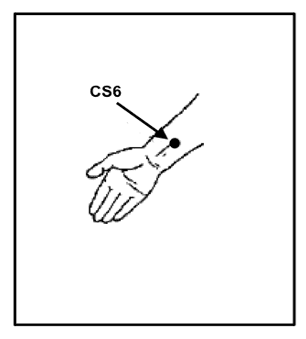
Dhillon 42, evaluated the performance of 20 male cyclists, subdivided into three groups: treated with systemic acupuncture: stomach 36 (Figure 1B), gallbladder 34 (Figure 11B), liver 11 (Figure 14), kidney 3 (Figure 11B), governor vessel 20 (Figure 12 ); sham acupuncture; control, without intervention. The athletes cycled by stationary bike for 20 km at their maximum supported speed. The analog scale of pain, visual, for the lower limbs, induced by exercise; Borg’s scale of perceived effort; post-exercise blood lactate concentrations. The acupuncture-induced group presented a higher score in the Borg Scale, meaning that the treatment promoted a greater effort during the activity and decreased the time of completion of the test.
Figure 14: liver 11 – 1 tsun below ingüinal; at the antero-medial edge of the threshold of the long adductor muscle
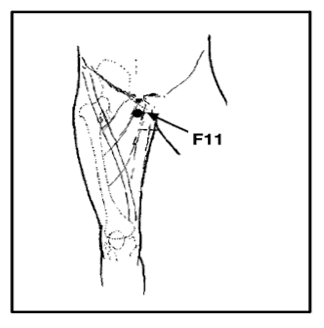
According to Hubscher 43, he evaluated the maximum jump with bipodal landing and voluntary maximum isometric strength of the quadriceps, with surface electromyography to measure femoral rectus muscle activity for 30 seconds of support. Thirty-three athletes were divided (13 female and 20 male) in three groups: systemic acupuncture using stomach points 36 (Figure 1B), spleen pancreas 6 (Figure 1A), vaso conception 6 (Figure 9); acupuncture group with non-existent points; Control group used laser disabled. As a result found, it was a non-significant increase in the maximum jump, but an important increase in the isometric strength of the quadriceps.
In another Geng 44 survey, he recruited 12 healthy men with physical education students between 19 and 25 years of age, evaluating the effects of ear acupuncture on blood lactic acid levels, induced by exercise on treadmill (VO2max). He chose the points: Liver, Lung, Subcortex, Endocrine Glands and Triple Heater (Figure 15). The results were an increase in oxygen capacity building and decreased blood lactic acid levels after exercises.
Figure 15: Ear Points
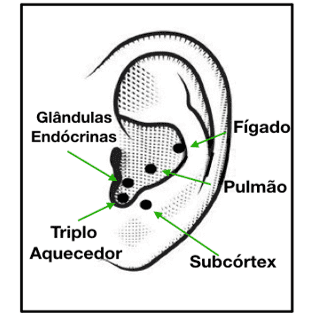
Another study of 28 male individuals divided into a control and experimental group. A data collection was performed before acupuncture sessions: Measurement of basal heart rate, through the oximeter; heart rate measurement after physical testing at Harvard Bank, with a height of 50 cm, performing ascents and descents for 5 minutes; heart rate measured in 1 and a half minutes of the test, 2 and a half minutes and 3 and a half minutes; calculation of the Physical Fitness Index (IAF); average heart rate and number of ascents and descents during harvard bank testing. The points were used: lung 10 and vaso conception 17 (Figure 16), small intestine 3 (Figure 3B), in order to tone and lead to muscle relaxation, strengthening tendons, lumbar spine and lower limbs. In the gallbladder points 34 (Figure 11B), spleen pancreas 4 and kidney 7 (Figure 16) were related to sedation to potentiate the movement of blood circulation (Xue) and lymph (Jing Yie). Eight sessions were performed, one each week and the results did not show a significant improvement in relation to heart rate and physical fitness. In increasing physical performance, climbs and descents from the Harvard Bank, the values were significant to the experimental group in relation to control. 36
Figure 16: lung 10 – on the palmar side, above the joint of the first digital metacarpal, between dark and light skins; vase conception 17 – in the median line of the sternum at the level of the nipple; kidney 7 – 2 tsun above Taixi (R3); on the antero-medial edge of the sole muscle; spleen pancreas 4 – on the medial side of the foot; 1 tsun behind the metatarsophal joint, at the junction of dark and light skin.
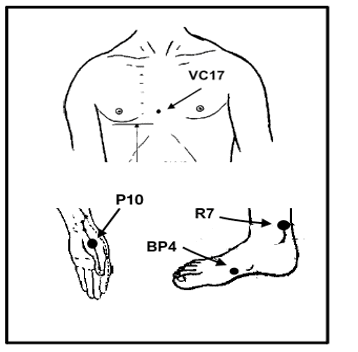
Fonseca 45, on the other hand, used a sample with 40 male individuals practicing muscle strain two groups: control and intervention to evaluate the effects of acupuncture on localized muscle endurance (RML) of the upper limbs. The control group was submitted to the RML test for 1 minute, going through a rest period of 30 minutes and after, the test was repeated.
In the intervention group, the test was applied: the test; rested for 5 minutes; application of acupuncture, toning the points: spleen pancreas 3 (Figure 1A); kidney 7 (Figure 16); stomach 36 (Figure 1B); governor’s vase 4; triple heater 15 (Figure 7); for 25 minutes. After applicability, the RML test repeated, resulting in a significant improvement in the muscle performance of the intervention group.
In 2015, Moniz, used 12 Rugby athletes where they were distributed in control group and test group, performing acupuncture for 20 minutes in the points: heart 5, bladder 15, bladder 44 (Figure 17) and circulation and sexuality 6 (Figure 13). In the second weekly session, punctures were performed at the stress points and trigger points. The results clearly suggested that the application of acupuncture brings advantages to athletes over muscle problems, with total recovery at pain level and limitation of movements before the subsequent play the injury.
Figure 17: heart 5 – on the ventral and ulnar side of the forearm, on the ulnar side of the tendon of the carpal ulnar flexor muscle; 1 tsun above handle; bladder 15 – at the lower edge level of the spinal process of the vertebra (T5), on the same vertical line as the Feishu point (B13); bladder 44 – 3 tsun, lateral of the axis, at the lower edge level of the vertebra spine (T6).
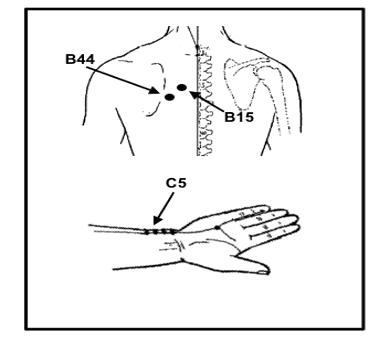
Most studies present significant results regarding the improvement of physical performance, consequently leading to an improvement in the time of end of the tests. This causes individuals submitted to acupuncture treatment, receiving an activation of pain control neurophysiology, triggering an improvement in muscle performance, greatly influencing the final result. 46
ACUPUNCTURE USED IN THE TREATMENT OF LESIONS
Acupuncture acts in this process of curing the disease, eliminating its cause, and thus is being administered both for the treatment of various acute and chronic pains. It can be used in surgical procedures, in the improvement of physical conditions and in the prevention of injuries in various sports. 24
Currently athletes and their coaches seek the improvement of physical performance and prevention through exhaustive training, nutritional monitoring, physiotherapeupic prevention, training plans, psychological monitoring and use of new sports equipment achieving objectives. Even with these enhanced systems, many athletes prefer and move on the fastest path, using illicit treatment, such as the use of anabolicsteroids and drugs. 32 According to Frasca 35, he states that acupuncture works in the human being as a whole, treating pain, improving performance and acting directly in the psychological system of athletes generating an increase in the psychic confidence of the sportsman.
According to Santos and collaborators 20, most athletes have had the experience of feeling late-onset muscle pain, which appear in training periods, where the intensity and volume of work are higher. Another type of pain is caused by an injury, moving athletes away from training and competitions for long periods. 21
Based on neurophysiology, histoanatomical and neurochemical, CTM explains that by punturating the point that is located in the channels of the specific meridians, it will facilitate the energy flow in these structures overloaded by sports modalities, achieving analgesic goals. 25, 47
Other authors report that the application of the technique has the action of endogenous opioids, the release of â-endorphin that is identified in pain modulation and inhibition of nociceptive transmission at all levels of the nervous system occurs.) through the use of electroacupuncture, positive regulation of the expression of the ratio of neural nitric oxide synthesis (nNOS) / NADPH diaphorase (NADPHd) occurs. measured through thalamic pathways and the dorsal medulla. There are also some data suggesting that in addition to opioids, other mechanisms are involved in the treatment of pain. 6, 48, 49, 50, 51
The presence of NO favors the improvement of local vascularization, indicating a homeostotic action of acupuncture, but the increase of NO in the icy fascicle may clarify this regulatory action of somatic reflexes caused by the technique. 6, 52 Other studies observe the release of serotonin after needle stimulation. 51, 52, 53
Acupuncture is applied to tone, relax athletes’ muscles and maintain the energy balance of the body. In addition to the analgesic effect, it is possible to stimulate other biological factors, activating the hypothalamus and pituitary gland reaching systemic effects, such as: increased neuro-hormones and neurotransmitters.² improving the athlete’s performance in their respective modalities, thus controlled by systems, nervous, endocrine and immune. 36, 54, 55, 56, 57, 58, 59, 60 Many studies have shown that acupuncture operates in these three systems, providing: relief of tensions and muscle pain; increased local blood flow; release of endogenous opioids, decreasing pain perception; improvement of the modulation of sympathetic and parasympathetic nervous system balance; modulation of the immune system; activation of connective tissue and muscles releasing myosins that have anti-inflammatory effects, releasing antioxidant substances, decreasing oxidative stress; substances that have probable ergogenic effects. 5, 13, 61, 62, 63, 64
In a laboratory study with rats, Lee and collaborators, 65 reported that the animal when submitted to acupuncture and exercise presented a suppression of the effects on 5 HT (5 hydroxytryptamines) and the expression of THP (hydroxylase tryptophan) in the dorsal rafe of guinea pigs, reaching ergogenic effect, since the 5 HT prevents the performance of exercise in humans and rats.
In one study, Zyloney and 66 collaborators reported that it is possible to find a different activity in the brain, through magnetic resonance assessment, during the needle procedure. These changes appear in regions such as: epiaquedural gray matter, hypothalamus, primary somatosensory cortex, upper temporal gyrus, rostral anterior cingulate cortex and medial region of the occipital cortex. 48
In his research, Minori 67 treated repetitive shoulder stress injuries, with the combination of wonderful vessel stitches: triple heater 5 – gallbladder 41 (Figure 18) that are used for chronic pain and small intestine 3 (Figure 3B) – bladder 62 ( Figure 11B) for acute pain.
Figure 18: triple heater 5 – 2 tsun above the dorsal fold of the wrist, between the tendons of the common digital extensor muscle and the fifth digit muscle itself; gallbladder 41 – in depression between the fourth and fifth metatarsals.
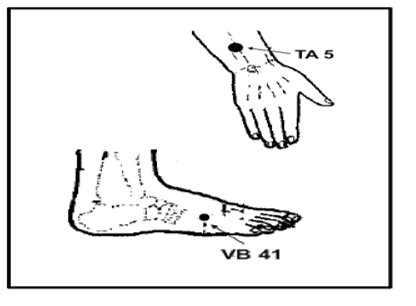
The local points for treatment are: large intestine 5 for wrist pain; large intestine 4 relieves pain and edemas (Figure 4 A); small intestine 9 arm pain; triple heater 14 indicated for pain and inflammation of the shoulder; large intestine 14 (Figure 19) used for stiffness, paresis, reduced shoulder mobility. Distant points, upper and anterior shoulder pain: stomach 36 to dissipate external pathogenic factors; stomach 37 indicated for pain, sensitivity and circulation disorders; stomach 41 eliminates moisture, stagnation, wind and soothes the shen (mind); stomach 38 eliminates acute pain and shoulder joint disorders (Figure 1B). For posterior and superior shoulder pain: gallbladder 34 indicated for reduced mobility, spasms, circulation disorders and functional disorders of muscles and tendons; gallbladder 38 disperses the wind and releases heat, activates the meridian and its vessels (Figure 11B). Pain scapula, on the other hand: bladder 65 pacifis and strengthens the spirit, releases heat and relieves pain; bladder 64 suppresses spasms and relaxes tendons; bladder 60 relieves pain and activates the meridian and emotional points (Figure 2A); bladder 18 promotes general calm and eliminates spasms (Figure 19) and liver 8 relaxes tendons (Figure 11A).
Figure 19: small intestine 9 – in the posttero-lower region of the shoulder joint, on the postteroinferior side of the larger round muscle; triple heater 14 – in depression between the achromic and the larger humerus tuberculo, at the edge of the infraspinal tendon; large intestine 14 – covers the side side and some radial of the arm, at the distal point of the deltoid muscle, 3 tsun below jianyu point; bladder 18 – on the same vertical line as geshu (B17), at the lower edge level of the spinal process of the vertebra (T9).
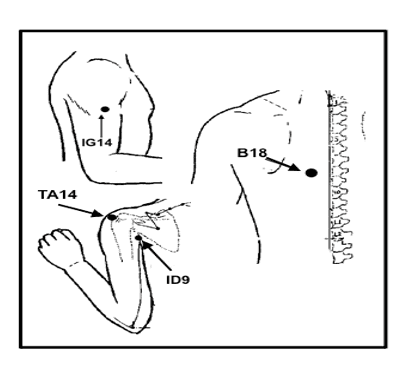
Brum 68, on the other hand, associated in his study to treat pyriform syndrome, massage and acupuncture techniques in corridors, in order to improve muscle functions, flexibility and relief of symptoms. The research included athletes of both sexes aged 30 to 60 years. The session focused on massage (Shiatsu) at the beginning to release the stress points of the gluteal and thigh region on the affected side, followed by needleing, as follows: clockwise; anti-time; deepening; superficializing the needle in the following regions: origin and insertion of the piriform muscle (pelvic face of the sacrum and larger trocanter of the femur); origin of the middle gluteus (lateral face of iliac bone); upper limit of the minimum gluteus; upper limit of the gluteus maximum; origin of hamstring muscles (sciaticatic tuberosity); femoral biceps muscle and semitendinous muscle diaphysis, finished with massage.
The results showed significant improvement, when related to the improvement of pain, flexibility, pain palpation in the piriform muscle and test for pyriform syndrome. This shows the agreement with the study by Hongwen 69, where the effectiveness of acupuncture was 97.33% and with the research of France 26 that associated the needles with kinesiotherapy reaching a relief of symptoms, the potentialization of the neuromuscular system, providing a faster return to sports activities.
In his work, Rocha 70, verified the improvement of the activation of the femoral rectus muscle, through electromyography, after stimulation of the stomach acupuncture point 45 (Figure 20). A total of 10 participants (5 males and 5 females) were selected, where they performed an exercise of 2 squat repetitions, where they selected the highest muscle activation index among the two movements by the electromyographic signal. Then acupuncture was applied, toning the stomach point 45 for 10 minutes and then the isometric squat was repeated in the lower phase. According to the results found acupuncture altered the electrical activity of the femoral rectus muscle during the isometric phase in the lower phase of the squat, proving effective.
Figure 20: stomach 45 – 0.1 tsun on the side of the side corner of the nail bed of the second toe
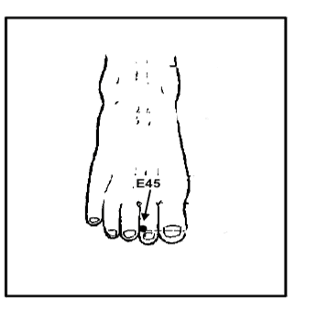
In another study Pinheiro 71, characterized and filed some points for the treatment of meniscal lesion: liver 8 (Figure 11A) used to tone the liver canal with function of harmonizing and toning liver and blood Qi, promoting the fullness of the kidneys and leading to the relaxation of tendons and muscles, strengthening the Iq of the knee. The bladder point 40 (Figure 5) is found in the popliteal fossa enabling: dispersion of heat and perverse wind of the limbs; relaxation of muscles and tendons; destroying blood vessels; reduces heat and eliminates blood stasis; decreased regidez and strengthens the knee and lumbar. On the other hand, the kidney point 10 (Figure 21) mobilizes water; tones yin Qi; expels moisture and perverse heat, treating knee pain, leg edema and numbing knee and popliteal cessum.
Figure 21: kidney 10 – on the medial side of popliteal fold, between semitendinous and semimembraous muscles
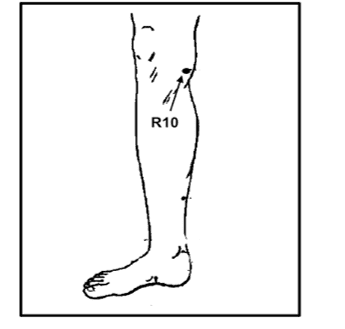
In a study on shoulder dysfunctions, Nunes 72, reviewed the bibliography and filed the points of wonderful vessels: small intestine 3 (Figure 3B) – bladder 62 (Figure 11B) to balance functions, relaxing muscles and tendons; the points of the triple heater 5 – gallbladder 41 (Figure 18) relieve pain and relax tendons; Ashi points; liver 8 (Figure 11A) and kidney 7 (Figure 16) to strengthen tendons; stomach 36 (Figure 1B) eliminating cold and moisture from the joints; intestine 4 (Figure 4A) and large intestine 15 (Figure 22) acting in the movement and pain of shoulder flexion; triple heater 14 (Figure 19) and large intestine 16 (Figure 22) improving extension mobility and pain.
Figure 22: large intestine 15 – on top of the shoulder, on the lateral edge of the acromion, there are two depressions, this point is in the anterior depression; large intestine 16 – in depression between the upper and posterior edge of the acromioclavicular joint and the spine of the scapula.
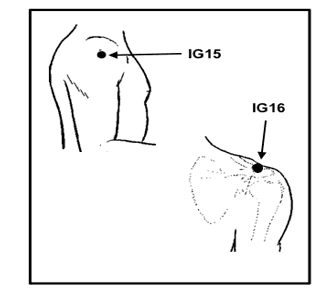
In order to verify the immediate effects of acupuncture on late-onset muscle pain (DMIT) and contractile functional capacity of muscles, Parisoto 73, selected 30 subjects (12 men and 18 women), aged between 20 and 30 years, practitioners of activity 2 to 3 times a week. They were divided into three groups: treated with acupuncture; placebo sham; Control. The following were evaluated: pain threshold with the algelometer; peak maximum isometric muscle strength; electromyographic activity; subjective perception of pain through the visual analog scale.
After the evaluations, the volunteers were submitted to induction of DMIT, performing flexion and extension of the elbow with load (biceps thread), up to the maximum limit of movement execution: 3 series were performed until muscle exhaustion with an interval of 4 to 5 minutes. After this procedure, the state in which the muscle was before acupuncture was reevaluated.
The points chosen for treatment of the acupuncture group were: large intestine 4 (Figure 4A), large intestine 11 (Figure 4B), stomach 36 (Figure 1B), gallbladder 34 (Figure 11B), which are analgesic and toning points of muscles and tendons. In the sham group, placebo points were used and the needles were introduced superficially; control group the individuals just lay down. Both groups remained at rest for 20 minutes.
The results indicated: perception of pain with the analog scale was reduced in the acupuncture group; the threshold of pain by the algelometer increased after intervention in this group. After acupuncture intervention, biceps muscle activation was reduced by 30% when related to the sham and control group. Muscle strength, after DMIT, decreased by 48% in the tested group, being lower than in the sham and control groups (58% and 56% respectively). All groups presented maximum isometric muscle strength deficit after the dmit induction protocol: acupuncture decreased by 26%; sham 29%; control 33.5%.
However, it was concluded that acupuncture was effective in immediate improvement of pain perception and increased threshold by algelomer, providing neuromuscular alterations, but not improving contractile performance of the musculature.
In another Tolentin study 74, it evaluated the effect of auriculotherapy on pain, functionality and mobility of individuals with chronic low back pain. Divided 31 participants into three groups: experimental with disposable stainless blood needles of 1.5 mm; experimental with mustard seeds; control without intervention. The visual analog scale was used to assess pain; for the functionality test, the Quebec lumbar disability questionnaire and the sitting to standing test were used; lumbar mobility was performed.
The interventions were performed for 4 weeks, being a weekly session, applied in the points: Shenmen, Rim, Sympathetic, Analgesia, Muscle Relaxation, Lumbar and Adrenal Spine (Figure 10). After an interval of 1 week after the last application, the individuals were reevaluated with the same protocol.
The results showed improvement in the condition of low back pain, as well as the improvement of functional capacity in both experimental groups, unlike the control that there was no significant difference in relation to initial pain. No difference was found between the techniques performed (needle and seed), indicating that both are beneficial for relief from chronic low back pain and increased functional capacity.
Figure 23: Ear points
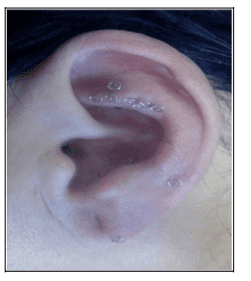
FINAL CONSIDERATIONS
Based on the literature, analyzing all the results and their scientific evidence, it is considered that acupuncture treatment is effective in the treatment, improvement of performance and prevention of injury in professional and amateur athletes. Individuals receiving the intervention, even if they have some type of injured complication, the problem is less severe and rapidly restoring organic function, that is, the athlete who suffers some type of injury and is performing acupuncture, this adversity will tend to be minimal and early return activities.
Even athletes who do not use acupuncture in order to prevent prevention and present the lesion, the intervention of this presents clinical evidence, based on neurophysiology, opioid release, with emphasis on the treatment of pain and improvement of the patient’s well-being .
Acupuncture intervention, although it is a millennial technique, is still growing in the West, has been performing great results in clinical practice, issues of prevention of musculoskeletal injuries, and also in the prevention and treatment of diseases psychosocial, acute and chronic pain.
Due to the balance of the energy system, acupuncture not only treats physical well-being, but also mental well-being, because the theoretical foundation of the technique does not separate the body from the mind benefiting emotional stress, reducing anxiety and balancing the human mind.
REFERENCES
- Ching N. O livro de ouro da medicina chinesa. 3. ed. Rio de Janeiro: Objetiva; 1991.
- Malveira CL, Souza FCS, Rocha TBX. Biomecânica do movimento isométrico de pedala antes e após aplicação de acupuntura: Um estudo preliminar. Motric. 2012 Set;8(52):630-9.
- Sousa NR. Relação entre a reatividade de pontos de acupuntura e atividade física com afecções ortopédicas determinadas por exames de imagens em equinos. Botucatu. Tese [Doutorado em Biotecnologia Animal] Universidade Estadual Paulista; 2015.
- Silveira NC, Martins RCC. Eficácia da acupuntura para o tratamento da fibromialgia: Uma revisão sistemática. Psicol e Saúde em Debate. 2018 Fev; 4(1):85-105.
- Sant’ Anna FM, Rangel VM, Mota DDS. Tratamento da Tenossinovite de De Quervain por Acupuntura – Relato de Caso. Vittalle. 2018 Mar; 30(1):130-6.
- Tsuchiya M, Sato EF, Inoue M, Asada A. Acupuncture enhances generation of nitric oxide and increases local circulation. Anesth Analg. 2007 Feb; 104(2):301-7.
- Tavares MG, Machado AP, Motta BG, Borsatto MC, Rosa AL, Xavier SP. Electro-acupuncture efficacy on pain control after mandibular third molar sugery. Brz Dent J. 2007; 18(2):158-62
- Hutchinson AJ, Ball S, Andrews JC, Jones GG. The effectiveness of acupuncture in theating chronic non-specific low back pain: a systematic review of the literature. J Otthop Surg Res. 2012 Oct 30;7:36.
- Moniz PJL. Avaliação da acupuntura no desempenho do rugby. Coimbra. Dissertação [Mestrado Integrado em Medicina] – Faculdade de Medicina da Universidade de Coimbra; 2015.
- Magalhães PC. Efeito da acupuntura na prevenção da hemorragia pulmonar induzida por exercício em cavalos puro sangue inglês de corrida. Botucatu. Dissertação [Mestrado em Biotecnologia Animal] – Universidade Estadual Paulista; 2016.
- Matias B et al. Acupuntura de equilíbrio como coadjuvante no tratamento de disfunções temporomandibulares. Ação Odonto. 2018 Jun; 1(1):65-72.
- Franco A. Acupuntura Ajuda Atletas nas Lesões e na Performance. Jornal da Madeira 2016 agosto 2;p.25.
- Lopes SS, Mota MPG. Efeito da acupuntura na resistência física após exercícios repetitivos de tornozelo – Estudo experimental. R bras Ci e Mov. 2018 Jul;26(1):13-21.
- Lopes SS, Mota MPG. Influência da acupuntura no limiar de percepção dolorosa de musculatura submetida a esforço repetitivo. Br J Pain. 2018 Jul; 1(3):207-11.
- Cohen M, Abdala RJ, Ejnisman B, Amaro JT. Lesões Ortopédicas no futebol, Rev. Bras. Ortop 1997 Dez;32(12):940-44.
- Dias Junior JC, Marino DM. Acupuntura na prevenção de lesões musculares em atletas de futebol profissional. Rev Fisioter S Fun. Jan-Jul:6(1):36-42.
- Wen TS. Acupuntura Clássica Chinesa. 15. ed. São Paulo: Cultrix, 2006.
- Maciocia G. Os fundamentos da medicina chinesa: um texto abrangente para acupunturistas e fitoterapeutas. São Paulo: Roca; 1996.
- Ross J. Combinações dos Pontos de Acupuntura: A Chave para o Êxito Clínico. 1 ed. São Paulo: Roca, 2003.
- Santos VC, Kawano MM, Banja RA. Acupuntura na melhora da performance em atletas juvenis de handebol, Rev Saúde e Pesq 2008 Set-Dez;1(3):331-35.
- Rubio K, Godoy Moreira F. A dor em corredores com fascite plantar: o uso da acupuntura, Rev Dor 2008 Jul-Set;9(3):1290-1296.
- Pires TF, Pellegrinotti IL. Acupuntura na Performance Atlética: Estudo Exploratório. [8ª Mostra Acadêmica da UNIMEP; 2010 out; 1-4; Piracicaba, Brasil].
- Yang HY, Liu TY, Gao M. Electrical acupoint stimulation increases athletes rapid strength, Zhongguo Zhen Jiu 2006 May;26(5): 313-315.
- Luna MP, Fernandes Filho J. Efeitos da Acupuntura na performance de Atletas velocista de alto rendimento do Rio de Janeiro. Fit e Perform J 2005 Julh/Ago;4(4):199-214.
- Ehrlich D, Haber P. Influence of acupuncture on pysical performance capacity and Haemodynamic Parameters. J. Sports Med 1992 May;13(6): 486-91.
- França D, Fernandes-Senna V, Cortez CM. Acupuntura cinética como efeito potencializador dos elementos moduladores do movimento no tratamento de lesões desportivas. Fisioter Bras 2004 mar-abr; 5(2):111-8.
- Wadsworth L T. Acupuncture in sports medicine. Curr Sports Med Rep 2006 Feb; 5(1):1-3.
- Barela J A. Estratégias de Controle em Movimentos Complexos: Ciclo Percepção – Ação no Controle Postural. Rev Paul de Educ Fís 2000; 3: 79-88.
- Papler PG et al. Reabilitação do joelho. In: Greve J.M. A. e Amattuzzi, M.M. Medicina de reabilitação aplicada à ortopedia e traumatologia. São Paulo: Roca, 1999.
- Gemeo LH. Ignatti C. Acupuntura como Ferramenta Auxiliar do Aumento da Performance Desportiva. In: Anais do Simpósio Internacional de Ciências Integradas da UNAERP; 2004 ; Guarujá, Brasil. São Paulo: Universidade de Ribeirão Preto Campus Guarujá; 2004. p. 1-9.
- Rossetto SC. Acupuntura nos Esportes. 1 ed. São Paulo: Phorte, 2009.
- Pelham TW, Holt LE, Stalker R. Acupuncture in human Performance. J Strength Cond Res 2001 May;15(2):266-71.
- Myamoto T. Acupuncture treatment for muscle injury. Japa Journ of Phys Fit and Spor Med 1997; 43(2):39-41.
- Fry AC, Kraemer KJ. Resistance exercise overtraining and overreaching: neuroendocrine responses. Sports Med 1997 Feb;23(2): 106-29.
- Frasca L. Desempenho na Ponta da Agulha. Rev Farmac 2011 out-nov:44-5.
- Costa V. Acupuntura Previne Lesões e ajuda a melhorar o Desempenho nas Pistas [periódico na internet]. 2013 [acesso em 22 jan 2017] Disponível em: http://blogs.oglobo.globo.com/pulso/post/acupuntura-previne-lesoes-ajuda-melhorar-desempenho-nas-pistas-500798.html.
- Luna M. Os Benefícios da Acupuntura no Esporte. 2016 [acesso em 22 jan 2017] Disponível em: http://www.ibramrp.com.br/noticia/49/os-beneficios-da-acupuntura-no-esporte.
- Akimoto T, Nakahori C, Aizawa K, Kimura F, Fukubayashi T, Kono I. Acupuncture and responses of imunoligic and endocrine markers during competition, Med Sci in Sports Exerc 2003 Ago;35(8):1296-1302.
- Bopp-Limoge C. L`acupuncture Permet-elle D`ameliorer les Performances Sportives Stude Personnelle a Propos de 35 Sportifs de haut niveau. These Medicine 1998; 117:215.
- Lin ZP et al. Effects of acupuncture stimulation on recovery ability for male elite basketball athletes. Amer Jour of Chin Med 2009; 37(3):471-81.
- Lin, ZP et al. Effect of auricular acupuncture on oxygen consumption of boxing athletes. Chin Med Jour 2009; 22(13):1587-90.
- Dhillon S et al. The acute effect of acupuncture on 20-km cycling performance. Clin Jour of Spo Med 2008; 18(1):76-80.
- Hubscher M et al. Immediate effects of acupuncture on strength performance: a ramdomized, controlled crossover trial. Euro Jour of Appli Physi 2010; 110(2):353-58.
- Geng L J et al. Investigation on the effects of ear acupressure on exercise-induced lactic acid levels and the implications for athletic training. Amer Jour of Acupu 1995; 23(4).
- Fonseca LP, Lessa JFM. Efeito da Aplicação da Acupuntura na Resistência Muscular Localizada de Membros Superiores em Praticantes de Exercício Resistido. Brasília. Monografia [Graduação em Fisioterapia] – Centro Universitário de Brasília; 2011.
- Belmiro H, Vicentini D, Camilotti CM. Efeitos da Acupuntura no Desempenho Motor de Atletas. Rev Fac Educ Fis 2013 jul-set; 11(3):176-91.
- Angeli AL, Fernandes JGJ, Luna SPL. Acupuncture Applied Equine Sports Medicine, Ver Acad 2007 Jul-Set;5(3):325-33.
- Staud R. Mechanisms of acupunture analgesia: effective therapy for musculoskeletal pain? Curr rheumatol Rep. 2007 Dec;9(6):473-81
- Bucinskaite V, Lundeberg T, Stenfors C, Ekblom A, Dahlin L, Theodorsson E. Effects of electro-acupuncture and pysical exercice on regional concentrations of neuropeptides in rat brain, Brain research 1994 Dec;666(1): 128-32.
- Shang C. Prospective tests on biological models of acupuncture. Evid Based Complement Alternat Med. 2009 Mar; 6(1):31-9.
- Bowsher D. Mechanisms of acupuncture. In: Filshie J, White A. editors. Medial Acupuncture: a western scientific approach. London: Churchill Livingstone; 1988:69-82.
- Ma SX. Neurobiology of acupuncture: Toward CAM. Evid Based Complement Alternat Med. 2004 Jun;1(1):41-7.
- Li J, Wang Q, Liang H, Dong H, Li Y, Ng EH, et al. Biophysical characteristics of meridians and acupoints: a systematic review. Evid Based Complement Alternat Med. 2012;2012793841.
- Cardeal EL, Oliveira KB, Aoki MN, Amarante MK, Oliveira CEC, Suzuki S, et al. Aspectos imunológicos da acupuntura. Biosaúde 2005 Dez:7(1/2):49-60.
- Szabó MVRS, Bechara GH. Acupuntura: Bases Científicas e Aplicações. Ciência rural 2001:31(6):1091-99
- Saad M. A Medicina tradicional chinesa tem base científica?. Einstein: Educ Contin Saúde 2008: 6(3):122-6.
- Alvarenga TF, Amaral CG, Steffen CP. Ação da acupuntura na neurofisiologia da dor: revisão bibliográfica. Rev Amazôn Scienc & Helth 2014 Out/Dez:2(4):29-36.
- Pereira FAO. Evidências científicas da ação da acupuntura. Perspectivas 2005 jan/jul:4(7):88-105.
- Taffarel MO, Freitas PMC. Acupuntura e analgesia: aplicações clínicas e principais acupontos. Ciênc Rural 2009 Dez:39(9): 2665-72.
- Lopes LF, Lopes MC, Fialho FAP, Gonçalves AL. Sistema de conhecimento para diagnóstico em acupuntura:uma modelagem usando o CommonKADS. Gest Prod 2010 Dez:x(x):1-15.
- Zhu J, Arsovska B, Kozovska K. Acupuncture treatment for sports injury – hamstring muscles group, Inter J Clin Exper Med Sci 2017 Nov;3(6):71-3.
- Vickers AJ, Cronin AM, Maschino AC, Lewith G, MacPherson H, Foster NE, et al. Acupuncture for chronic pain individual patient data meta-analysis, Arch Intern Med 2012 Oct;172(19):1444-53.
- Toda S. Effect of acupuncture on carnitine for skeletal muscle fatigue, Chin Med 2012 Jan;3:9-12.
- Lopes SS, Mota MPG. Influência da acupuntura no limiar de percepção dolorosa de musculatura submetida a esforço repetitivo, Br J Pain 2018 jul-set;1(3):207-11.
- Lee, SH, Chung, SH, Lee, JS, Kim, SS, Shin, HD, Lim, BV, et al. Effects Acupunturaq on the 5-hydroxytryptamine synthesis and tryptophan hydroxylase expression in dorsal in the dorsal raphe of exercice rats. Neurocienses Letters 2002 Oct;332(1): 17-20.
- Zyloney CE, Jensen K, Polich G, Loiotile RE, Cheetham A, LaViolette PS, et al. Imaging the functional connectivity of the Periaqueductal Gray during genuine and sham electroacupuncture treatment. Mol pain. 2010 Nov;6:80
- Minori AET, Mejia DPM. Atuação da Acupuntura para o Tratamento de LER/DORT no Ombro. Goiânia. Monografia [Pós Graduação em Acupuntura] – Faculdade Ávila; 2007.
- Brum KN, Alonso, AC, Brech GC. Tratamento de massagem e acupuntura em corredoresrecreacionais com síndrome do piriforme. Arq Cienc Sau 2009 abr-jun; 16(2): 62-6.
- Hongwen S. Clinical Observation on Acupuncture Treatment of Piriformis Syndrome. J Tradit Chin Med. 2003 mar; 23(1):38-9.
- Rocha TBX, Vilela Junior GB, Martins GC, Manzatto L, Grande AJ. Análise Comparativa Eletromiográfica do Reto Femoral em Isometria na Posição Inferior do Agachamento Wall Slide, antes e após a Aplicação da Acupuntura no Ponto ST45. Rev Bras Cien e Mov 2012 jul; 20(4):92-8.
- Pinheiro RG, Mejia DPM. Efeito da Acupuntura na Melhora do Paciente com Quadro Álgico de Lesão de Menisco Medial. Goiânia. Monografia [Pós Graduação em Acupuntura] – Faculdade Ávila; 2012.
- Nunes EA, Mejia DPM. Tratamento de Acupuntura para Combater Dores nos Ombros. Goiânia. Monografia [Pós Graduação em Acupuntura] – Faculdade Ávila; 2012.
- Parisotto D. Efeito Imediato da Aplicação da Acupuntura na Dor Muscular Tardia e na Capacidade de Contração Muscular. Curitiba. Dissertação [Mestrado em Fisiologia] – Universidade Federal do Paraná; 2014.
- Tolentino F. Efeito de um Tratamento comAuriculoterapia na Dor, Funcionalidade e Mobilidade de Adultos com Dor Lombar Crônica. Rio Claro. Dissertação [Mestrado em Desenvolvimento Humano e Tecnologias] – Universidade Estadual Paulista – UNESP; 2016.
[1] Degree in Physiotherapy from the University Center of Araraquara – UNIARA – 2005 (Araraquara-SP); Lato sensu postgraduate studies in Orthopedic and Traumatological Physiotherapy from the Cohen Institute – Orthopedics, Rehabilitation and Sports Medicine – 2006 (São Paulo-SP)Training in Osteopathic Manual Therapy by the Cefisa Institute – 2008 (Araraquara-SP); Professional Improvement in Global Postural Reeducation and Sensory Motor Reprogramming – RPG/RSM by the Paulista Institute of Systemic Studies – IPES – 2010 (Ribeirão Preto-SP); Lato sensu graduate studies in Systemic Acupuncture from the Paulista Institute of Systemic Studies – IPES – 2013 (Ribeirão Preto-SP); Stricto sensu Postgraduate Master’s degree in Territorial development and environment from the University Center of Araraquara – UNIARA – 2016 (Araraquara – SP); Professional Improvement in Clinical and Functional Pilates by the Paulista Institute of Systemic Studies – IPES – 2016 (Ribeirão Preto-SP).
Submitted: April, 2019.
Approved: October, 2019.
